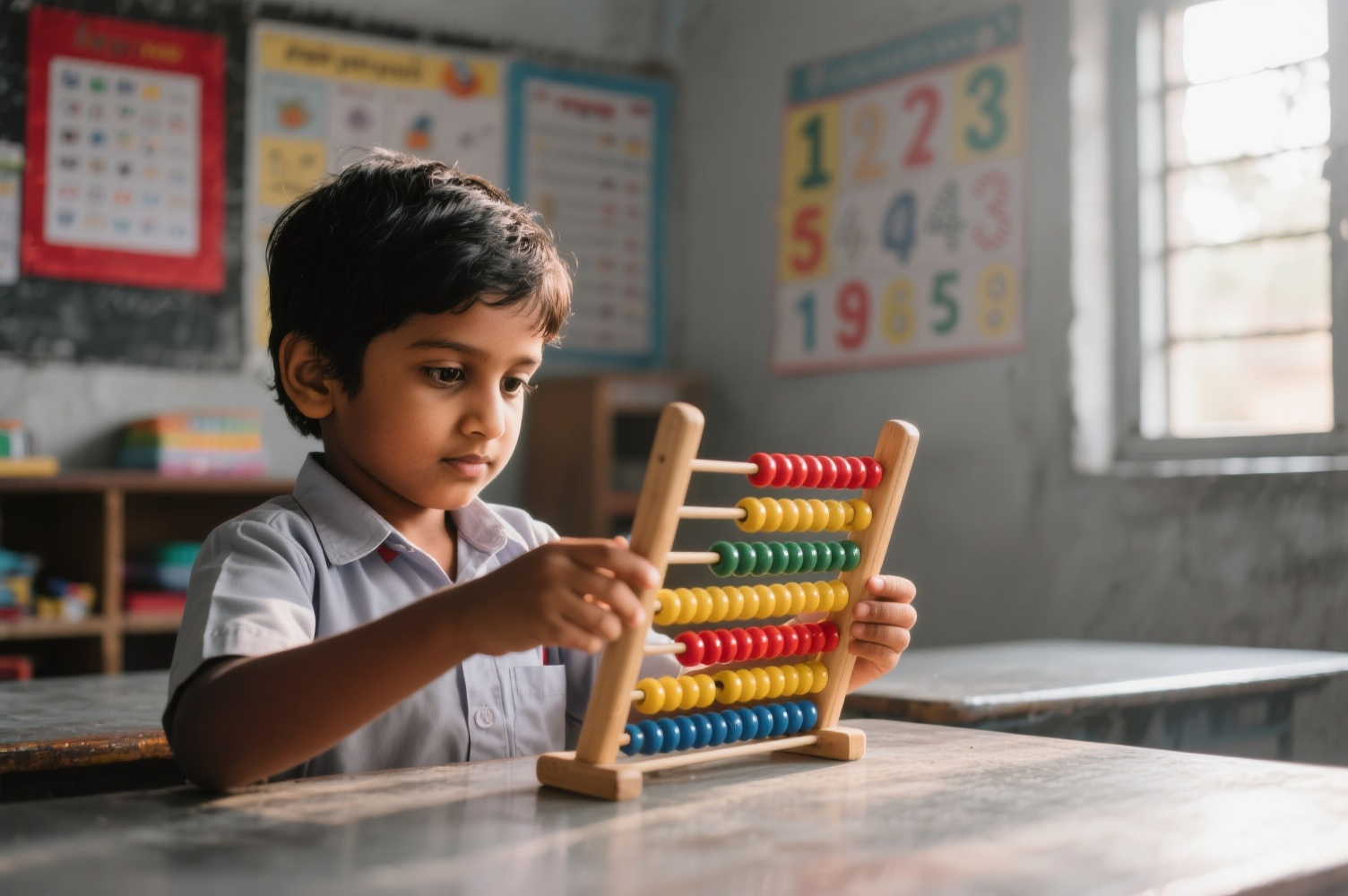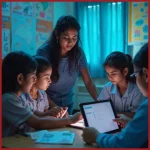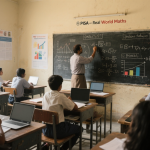- December 13, 2023
- by Educational Initiatives
- Blog
- 0 Comments
A student’s mathematical knowledge is built on a basic understanding of numbers and basic arithmetic operations. We refer to these skills, which should be acquired by class 5, as ‘Foundational Numeracy’ skills. Several studies have shown that students who perform poorly on these skills at the end of kindergarten and class 1 are likely to perform poorly in mathematics through class 4.[1] If students are unable to attain basic numeracy skills by class 5, they tend to fall behind, creating wide learning gaps.
Proficiency in foundational numeracy skills also predicts the presence of mathematics learning disabilities.[2] Attaining foundational skills in the early years also ensures that all students are given equal opportunity to perform well in schools by making it easier for them to gain new skills.[3]
We have observed, through our Personalised Adaptive Learning Programme Mindspark, and through various student interactions, that class 1 students from government (public) schools tend to exhibit much lower performance and knowledge of foundational skills compared to students from high-fee private schools.[4] (While some consider such comparisons invalid because of the vastly different home resources between these two groups, many countries have shown that children from even the poorest backgrounds can acquire foundational skills well. For us, therefore, the high fee private school performance merely marks the learning level that all students can and must acheive.)
A study conducted by EI on foundational numeracy levels across 3 Indian states (Himachal Pradesh, Rajasthan, and Telangana) showed that the performance of government school students lags significantly behind. This study also revealed skill-wise differences in numeracy tasks for students at the end of class 1. Students at the end of class 1 are expected to master some of the foundational numeracy skills shown below:
● Number recognition: While it may seem a very easy skill, the ability of children to quickly be able to recognise and read out 1 and 2 digit numbers turns out to be a very critical one. Indeed, only 33 percent of government school students in Himachal Pradesh (the best-performing state in the study) could accurately recognise 10 numbers shown compared to 92 percent students from private schools. Students were given 10 numbers to read. Responses for each were registered.

● Number writing: Only 26 percent of government school students in Himachal Pradesh could accurately write 10 numbers compared to 87 percent students from private schools. 10 number-words were recited to the students one by one and they were expected to write the numerals for the corresponding number-word.

● Number comparison: 76 percent of government school students in Himachal Pradesh could accurately compare 10 pairs of numbers as compared to 98 percent students from private schools. Students were presented with 10 different pairs of numbers and were asked to identify the bigger number, e.g. “Which is bigger, 17 or 71?”

Similar trends are seen across all other skills and paint a disheartening picture. After a year spent in class 1, students in government schools are not even close to where they need them to be in order for them to gain new skills at later grade levels. Repeated practice is undoubtedly a key ingredient for the acquisition of the above skills. The absence of home support is a crucial advantage for private school students – and teaching in public schools must be planned accounting for this. Testing these foundational skills every quarter, for example, and providing teachers benchmarks for levels students must achieve are ways to make this a part of the school’s role.
In order to master single digit addition facts, for example, students should be able to recognise numbers, understand cardinality,[5] employ addition strategies, and know how to write numbers. Writing needs fine motor skills to have been developed. Developmentally, acquiring fine motor skills is a time-taking process and requires practice to move from scribbling to forming numerals accurately. Probably the biggest challenge is when teachers do not understand the importance of these milestones and – for example – expect a child who is not able to fluently identify numbers to start learning addition.
Catching them young? There are countries like Finland that believe that formal education should not be started before the age of seven. However, that may be true in a context where the family can provide basic educational support needed in those years. When these supports are missing – including in cases where the parents may be illiterate, pre-schooling to provide ‘learning readiness’ can play a major role in developing pre-numeracy skills. Repetitive, slow-paced exposure provided to children in the context of games or real-world activities can help build these foundational skills. The India Early Childhood Education Impact study, conducted by the ASER Centre and the Centre for Early Childhood Education and Development indicates that children who were exposed to high-quality preschooling were more ‘school ready’ than those who were not. The five-year longitudinal study tracked close to 13,000 children across 3 states in India and shows that building children’s cognitive, pre-literacy and pre-numeracy skills during the preschooling stage improves their learning outcomes in early primary classes.
However, balwadis which are essentially government run child care centres for children before schooling age, focus on health and nutrition (which are definitely of primary importance) but do not have a curriculum that would help acquisition of foundational skills. A few changes here and inclusion of activities that would develop foundational skills (and the necessary training of balwadi staff) would go a long way in addressing this gap in foundational learning. The power of this is illustrated by a finding in the US that the average cost of prschooling a child may be $6,000–12,000, but the savings in terms of later services are estimated at about $30,000–120,000![6]
A test of foundational skills conducted by us on 30 students across four balwadis in Ahmedabad revealed that many 4.5 to 6 year olds, (who were going to class 1) could not draw a straight line using a pencil. In contrast, across most private preschools, driven by admission criteria in private schools for class 1, students between 4.5 to 6 years are able to write numbers and sometimes even know number names up to 20. Similarly, while most private preschool students are able to recognise numerals, the test in balwadis reveals less than 20% of students are able to recognise numerals accurately.
It is therefore important to understand where the gaps exist and how they can be bridged effectively. We see the need for early interventions to ensure student proficiency in early number competencies. In the absence of such interventions in balwadis, we must ensure that necessary support and focus is given to foundational skills in class 1. This is even more important for students from low-income backgrounds because these children enter class 1 well behind their peers from middle-income families on numeracy indicators, and this gap increases during the course of the school year.[7]
We also believe that repetitive exposure to such skills provided with immediate feedback and based on the personalised performance of each child, possible through programmes like Mindspark, can help students acquire these foundational skills. Technology assisted classroom learning, even with exposure durations of 30-60 minutes a week seem to result in significant improvements. However, states tend to prefer the use of educational technology tools to improve board exam results than foundational learning and there is a need for larger implementations to verify and scale up these results.
References and footnotes:
1. Duncan et al., 2007, “School readiness and later achievment”; Jordan, Kaplan, Ramineni, & Locuniak, 2009, “Early Math Matters: Kindergarten Number Competence and Later Mathematics Outcomes”; Morgan, Farkas, & Wu, 2009, “Five-year Growth Trajectories of Kindergarten Children With Learning Difficulties in Mathematics”.
2. Mazzocco & Thompson, 2005, “Kindergarten Predictors of Math Learning Disability”, Learning Disabilities Research & Practice.
3. Jordan, Kaplan, Ramineni & Locuniak, 2009, “Early Math Matters: Kindergarten Number Competence and Later Mathematics Outcomes”, American Psychology Association.
4. All the references to ‘private schools’ in this article refer to high-fee private schools which can be considered schools charging above Rs 20,000 monthly fees.
5. Like most concepts in foundational learning, the idea of cardinality ‘the total number of objects in a group’ sounds simple to us but is not trivial for a child to acquire.
6. Abadzi, Helen, 2006, “Efficient Learning for the Poor: Insights from the Frontier of Cognitive Neuroscience”. Washington, DC : World Bank. © World Bank.
7. Jordan & Levine, 2009, “Socioeconomic variation, number competence, and mathematics learning difficulties in young children”, Developmental Disabilities Research Reviews.



